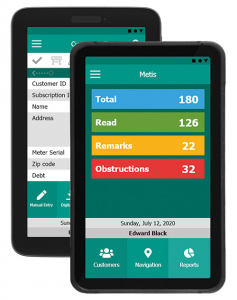Meter Reading
In the past, the reading of electricity, water and gas meters has been carried out manually and recorded into paper checklists by meter reader. As the energy industry has progressed around the world, meter readings have also progressed dramatically.
Today, with the production of new generation meters, meter reading methods are generally divided in two ways:
- Presence Reading: The traditional method of reading meter, which is nowadays more accurate and efficient with reader devices and applications.
- Remote Reading: It is performed on readings of meters without the use of human resources and methods such as GPRS modems.
German Metering GmbH with years of experiences in the industry, has products to help energy companies to read and monitor their metering equipment with various methods.
1. Presence Reading
1.1 Handwritten Reading
Presence readings are typically performed by the meter reader, so that they read and record the meter index on handheld or tablet. In the past, they recorded on checklists that this method had high human error. There is a similar method to read meters that reader point the camera of handheld or tablet to the meter and with OCR technology the meter index has been recorded, this method used for mechanical meters and has error sometimes, because of reading wrong numbers by handheld or tablet in some cases.
German Metering GmbH’s Metis is an application designed for reading electricity meters that despite having all the capabilities of former meter reading hand-held devices, has a unique user interface and great performance. The new UI enables various report and graph generations. It can be installed on a variety of smart phones and tablets, benefiting from Android. These are just some of the capabilities of this application.
1.2 Using Optical Probe
Another method of meter reading is optical reading with a probe. The optical probe placed on the meter’s optical port. Then, on the handheld/tablet reader executes the read command, and at that time, not only the meter index, but also many other factors are automatically read in accordance with the settings. This method is much faster, more efficient, and free from human error. In many companies this method is used by now.
The features of the meter reader (handheld) are limited to the hardware provided by the manufacturer. Nowadays, due to the widespread adoption of smartphones and tablets, manufacturers have come to develop reader software under the Android and other operating systems. The user with these systems is much easier than the previous systems.
German Metering GmbH is producer of Optical Probes with a wide range of types included wired and wireless. Wired optical probes with various connectors and wireless probes with Bluetooth radio can cover any application. Optical probes work with handheld devices and Windows, Linux, Android and iOS devices depend on the model.
1.3 Using RF Module
Another meter reading method was developed for the reading of the meter’s RF module, in which the meters are equipped with a radio module (RF). In this case, the meter reader will only walk pedestrians or riders from the front of the house door or near the meters and will place its reader in the mode of receiving information. At this time, information is automatically transmitted wirelessly and no longer requires entry into the home.
Even though the ease of reading is higher and the reading time is less, there are still some defects. The biggest defect in this system is the high energy consumption, because the RF transmitter, which is installed next to the meter, is continuously transmitting in short intervals, while the meter reader only once a month for reading Referring Also, in high-density subscribers, the time to get information into the meter reader goes up, which slows down the reading process.
2. Remote Reading
2.1 Data Collector Unit (DCU)
To solve the meter reading problems, the remote reading system was proposed using data collectors (DCU). In this system, information is transmitted locally to the DCU device within the scope of sending and after data collection through the LAN or GPRS to the data center.

For example, the data collector is installed next to the digital electricity meters and communicates with them using the communication ports of the meters. If the installed meters have an RS-485 electrical port, by creating the network between the meters (maximum 256 meters), by placing the DCU device next to them, the meters can be read in order and their information can be stored in a certain period of time. DCU is connected to the mobile network through the GSM/GPRS platform by inserted SIM card, and communicates with the central server and the remote reading software, through the software, the required commands are sent to the DCU and it sends its collected data to the software.
2.2 Industrial/Transparent Modem
Using Industrial or Transparent Modems in one of the meter reading methods. These modems install next to meters and they can communicate with each other. These modems can connect to server via LAN/GSM/GPRS to send/receive data. A data management software installed on the server and by using it we can online monitor the meters and control them by sending turn on/off commands to them. Each modem can support 1 to 256 meters depending on meters type and their supported protocols. There are no differences between meters types, they can be electricity, water or gas meters.

Remote Reading Systems can be used in SCADA and MDM systems. The collected data can be used in energy consumption management. Collecting data will be very fast, accurate and easy compared with Presence Reading method. Online monitoring is possible by this method. Other advantage of this method is accurate billing.








